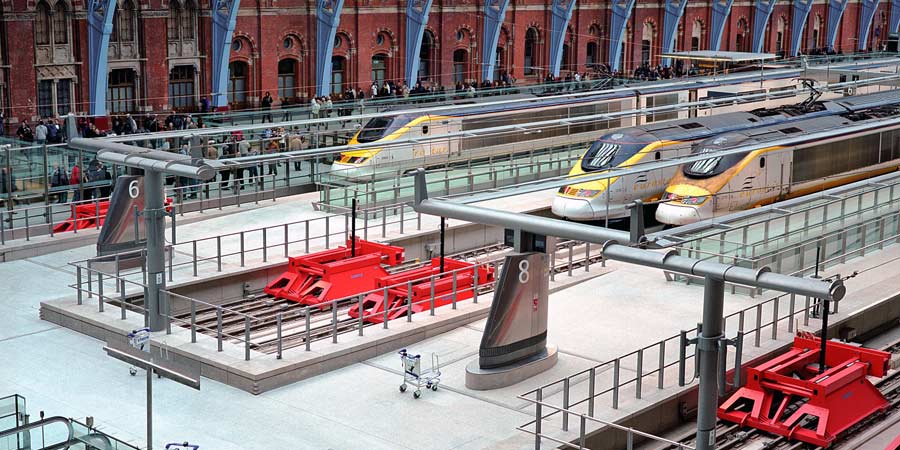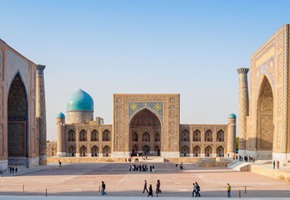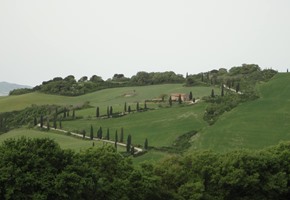King's Cross St Pancras, simultaneously a testament to the pioneering Victorians and modern, forward-looking stations, is one of the largest transport interchanges in Europe. Aligned at ground level, the two terminus stations are connected both by a pedestrian underpass and a shared Underground railway complex - which is London's best-served Underground station, with six lines running through it.
Both built during the first great railway age, the beautiful stations have had fascinating histories involving railway politics, neglect, and triumphant rebirths that have resulted in an invigorating 21st century overhaul. Now ranking as one of the world's best rail experiences, the rail hub forms an exciting part of a Europe-bound Great Rail Journeys holiday experience, and this section details their story, along with facts and figures and details of their modern-day facilities.
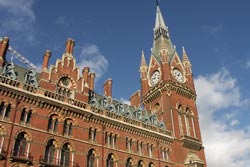
Like so many railway routes and buildings, St Pancras station was constructed as a result of railway politics, dictated by shareholders and landowners as much as by its designers or engineers. The station was built by the Midland Railway Company some two decades after the height of "Railway Mania", once they decided to truly branch out into longer-distance services. When they attempted to extend into the north and Scotland, they were effectively forced having to build the outstanding Settle - Carlisle Line after calling a bluff in Parliament. For journeys to the south, the Midland used the Great Northern Railway's London terminus at King's Cross, with occasional diversions into Euston when the need arose. But priority was naturally given to other trains, and when gridlock began to occur with unsettling regularity, in 1862 it was decided that the Midland Railway needed a London route - and of course a station - of its own.
St Pancras railway station - along with the new route to London from the Midlands - was constructed between 1865 and 1868. Designed by William Henry Barlow, the station was intended to be truly spectacular, to attract passengers to use the new line. Few could dispute that he succeeded; the magnificent station was characterised by its classic curved glass train shed, flanked by industrial cast iron and graceful brick arches. At the time, the station had the largest roof not to have a central support span, and remains to this day one of the largest enclosed spaces in the world.
These attractive flourishes were then complemented on the completion of the beautiful hotel in 1873. This incredible Gothic structure, with its distinctive turrets and spires, was designed by George Gilbert Scott and opened at the station's southern entrance. Both the station and the hotel quickly became icons of the London skyline, and were admired by architects and passengers alike. The new rail services were a great success, and St Pancras was soon handling a high volume of traffic. Arriving relatively late to the railway network, these two buildings were arguably the pinnacle of the first railway age. The future looked very bright; St Pancras was destined for great things.
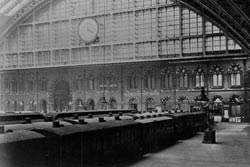
St Pancras station had got off to a fine start immediately after opening in 1868, and it remained a popular, well-used station for several years. However, following the First World War, much of Britain's railway network and infrastructure was exhausted, due to poor maintenance and obvious lack of funding.
In 1923, the railways were subject to the Grouping - in which the individual private companies were amalgamated into four main organisations - to help the railways recover. The Midland Railway was absorbed into the London, Midland & Scottish Railway (LMS). But they decided on using Euston as their main London headquarters - and from then on St Pancras went into decline. Rail services dwindled and the beautiful hotel closed, being used instead as office space.
Soon after came the Second World War, and St Pancras was a target for bombing during the Blitz. Whilst the damage was not too severe, the station was generally regarded as redundant from that point. More or less half of the platform space was tarmacked over - a saddening sight for this already under-used station.
St Pancras was now apparently in free fall to terminal decline - for much of the 1960s there were serious plans to demolish both the station building and the former hotel. In one of rail travel's darkest decades, when almost one-third of Britain's tracks were lifted, both buildings were very nearly victims of the wrecking ball; they came within ten days of being demolished and redeveloped as a sports hall and social housing. In the end it came down to a survival campaign led by Sir John Betjeman, who finally managed to convince the English Heritage to step in and give the buildings Grade I listed status in November 1967.
Although this gave the station more protection, the fact it had come so close to demolition in the first place showed that British Rail were not really prepared to make any improvements. And they didn't; for the next 30 or so years very little changed. The station was much maligned, and - although its beauty and status as an architectural feat was never in question - this wonderful landmark was allowed to continue operating in an ever-worsening state of repair.
By the 1990s, St Pancras felt like a sad relic, a poignant landmark desperately clinging on to what had been a great past, but which had been shamefully sidelined by successive rail organisations. It would take something truly extraordinary to restore the station to its former glory. Then remarkably, an opportunity presented itself. Once the decade-long Channel Tunnel project had been completed, the Eurostar services to Paris and Brussels were launched in 1994. Proving to be a considerable success, these trains paved the way for one of rail's greatest comebacks - and St Pancras' finest hour. One thing St Pancras always had going for it, even in its darkest days, was its fantastic location for central London and for its ease of access from other London termini. This meant that people from all over the country could theoretically reach St Pancras relatively easily once they had arrived in London, regardless of where they had started from. It was also going to be very close to the High Speed I, the next phase of the Eurostar and Channel Tunnel development.
So, although the Eurostar was based at London Waterloo, it made perfect sense to relocate to under-used St Pancras with its easily accessible central location once High Speed I was complete. In 2001 the first stage of St Pancras' long-overdue restoration and redevelopment began. Over the course of the following six years, the station was sympathetically redesigned to include six Eurostar platforms - along with dedicated Departures and Arrivals sections, and a border control area. Also new were three domestic platforms to serve the south east and Kent, and an additional two lower-level platforms for suburban London trains. This was all achieved without substantially altering the shape, design or layout of the station itself. The largest change was that the station's undercroft - which had historically been used to store beer from Burton-on-Trent, but had remained unused for decades - was opened up and redeveloped, creating a vast space for shops and restaurants below the tracks.
The beautiful station building was also painstakingly repaired to complement the additional building work. The glass roof was renovated and the brickwork was scrubbed, though some of this was in such a poor state of repair that the bricks had to be replaced. The grand iron arches spanning the roof were restored and repainted in a bright blue to truly freshen them up.
After a lot of effort and tireless restoration work costing £800 million, the superbly revamped St Pancras International was formally opened by Queen Elizabeth II as part of a regal ceremony in November 2007 - fittingly 40 years to the month that the building was saved from total destruction. With its magnificent transformation now complete, St Pancras went from being a dilapidated relic of the railways' bygone former glories, to a true cornerstone of the new railway age - heralding the era of international rail travel. Now once again a much-loved iconic London landmark, the station can continue proudly looking forward to its fantastic future.
6 - the number of years that the restoration took place (2001 - 2007)
150 - the tonnes of dirt cleaned from the brickwork
60 million - bricks cleaned in the project
1 million - bricks that had to be replaced because they were in too poor a state of repair to be cleaned. The new bricks were sourced using the same Leicestershire clay as the originals, to ensure that they matched
2.5 - acres of glass used in the famous roof. This is more than 9,400m², which is 38 tennis courts, or roughly two football pitches. This is one of the largest enclosed spaces in the world
18,000 - number of glass panes used to restore the roof
96 - length in metres of Searcy's Champagne Bar, which is by far the longest in Europe
455 - length in metres of a Eurostar platform
15 - the number of railway platforms (from just 5 in 2000)
60 - the number of shops and restaurants across the station complex
8,000 - total number of people involved in the restoration 3,500 - most people working on the site at any one time
500 - average number of people working on site on any given day of the restoration project
800 million - the total cost in pounds of the renovation work
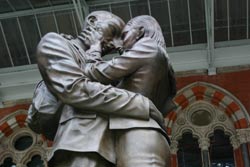
On the completion of the renovation works at St Pancras, a sculpture was commissioned to celebrate the station's new lease of life. Paul Day - whose previous works included the Battle of Britain Monument on the Victoria Embankment - was chosen to create the piece, called "the Meeting Place".
Designed to reflect the romance of rail travel, the classic scene of a couple embracing was modelled by the sculptor and his wife Catherine. The piece was made entirely in bronze, and was completed in sections owing to its size - it is an incredible 30 feet tall. Work on the final design was relatively quick, taking just over three months to complete.
At the base of the sculpture is a frieze, also depicting memorable scenes of separation and reunion. The grand display of the two people reuniting under the clock makes a distinctive silhouette, which was a key aim, as this huge artwork was always meant to be a focal point, and a convenient "Meeting Place".
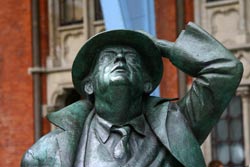
The celebrated poet Sir John Betjeman was known for his love of Victorian architecture and was a founding member of the Victorian Society. The group was formed to preserve a number of 19th and early 20th Century buildings that were at serious risk of demolition, as they had fallen out of favour in the intervening years.
Against the backdrop of savage cuts to the railways, in the 1960s Betjeman and the society fought some of their most difficult battles - those of saving the beautiful railway termini of London. In 1962, the group lost a well-publicised struggle to save the original Euston station and its iconic Doric arch. Whilst this remains a divisive decision to this day, at the time it was considered a step in the right direction for progress.
When plans were made to demolish St Pancras and its former hotel just five years later, Sir John Betjeman was vociferous in his opposition to the plans. He wrote to the national newspapers and enlisted the support of other national institutions. His actions were instrumental in the station's ultimate reprieve from total destruction in 1967.
In recognition of the importance of Betjeman's campaign, when St Pancras finally redeveloped a statue was created to honour the poet laureate. The bronze statue, created by artist Martin Jennings, is seven feet tall, and is adorned with quotes from some of the poet's best loved works. It was unveiled by Betjeman's daughter Candida Lycett Green. Situated on the upper concourse, the statue shows Betjeman as he was often seen - gazing up at the spacious roof of the train shed.
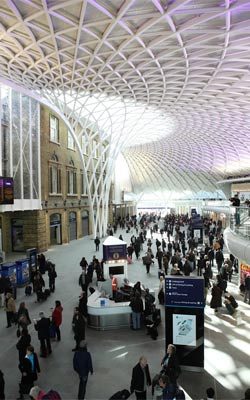
Planned as the London terminus of the Great Northern Railway in the late 1840s, King's Cross was constructed from 1851 and opened for traffic in the October of the following year. It was one of the earliest stations built in the capital, and at the time of its completion it was without doubt the grandest. Constructed to a simple but impressive style, the spacious honey-stoned building featured a twin-spanned glass train shed, giving the station a bright and airy feel.
For decades after its completion, the line and station went from strength to strength; its Anglo-Scottish services gained a fantastic reputation, and a number of its named trains - most famously the Flying Scotsman - were celebrated as being synonymous with comfort, efficiency and style. King's Cross avoided substantial war damage, and survived the 1960s remarkably well, considering the huge cuts and closures that British Rail made in light of the Beeching Report. Nevertheless, the station had seen remarkably little change or refurbishment in more than a century - certainly far less change than any of the other London terminals - and was looking especially tired and grimy by the late 1980s.
In the late 1990s and early 2000s, King's Cross gained notoriety from a newly-named train. The fictional "Hogwarts Express" from the Harry Potter series ensured that tourists from all over the world began to visit the station, celebrating a real-life location of JK Rowling's fantasy universe. After handling the increased levels of traffic for a while, it became apparent that the shabby, run-down station was now in need of an overhaul. Once St Pancras was confirmed as the new home of the Eurostar and its renovation was announced, it was the perfect time to refurbish King's Cross to complement its neighbour station.
The earliest stage of the process was the creation of Platform 0, an additional platform on the station's eastern side. The trainshed's double roof was also reglazed; having been ignored for a number of years, much of the glass had been removed and replaced with temporary boards, making the station dark and dull. The station was also de-cluttered and cleaned up at ground level, to make it more spacious.
For the next phase of the renovation, a new western-facing concourse was created. This was done for two reasons; the first was so that the crowded 1970s green concourse at the southern end could be removed, leaving the station's classic original frontage on show, framing a new attractive square. The other reason was so that the main passenger waiting area made a seamless and more natural connection with St Pancras just opposite. Some of the formerly disused areas on that side were brought back in to use, such as the Grade I listed timber-framed parcel office, which is now a tempting real ale pub.
The spacious, semi-circular concourse is a delight. Divided into Departures and Arrivals sections, it is three times the size of the previous concourse, and boasts many fantastic eateries and shops. The bright hall is characterised by its magnificent 'cascading' metal roof frame. Holding up the new structure against the scrubbed brick of the main Grade II listed building, this unique roof support gives the impression of swooping upwards, and consists of more than 2,000 solid and glass panels, all interspersed with coloured lighting. It strikes as the keynote of this most modern yet sympathetic overhaul.
In total, some £400 million was spent on the renovation works - and the result is a fittingly glamorous overhaul to bring the historic King's Cross station in line with its fellow interchange at St Pancras. Both are thoroughly up-to-date and exciting places to start or end your rail adventure.

